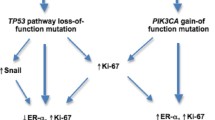Abstract
Background: Many invasive breast cancers are accompanied by a variety of noninvasive components. Histological distinctions have been made between these components, but to understand their importance, it is essential to examine their molecular biology.
Methods: Proliferative indices, oncoproteins, and steroid receptor expression were compared for invasive breast cancers containing comedo-type ductal carcinoma in situ (n=35), noncomedo-type ductal carcinoma in situ (n=34), and pure invasive cancers (n=49). Ploidy, S-phase fraction, Ki-67 staining, estrogen receptor (ER), progesterone receptor (PR), and the expression of HER-2/neu and epidermal growth factor receptor (EGFR) were evaluated in these tumors.
Results: The comedo-invasive subgroup differed significantly from the noncomedoinvasive subgroup, demonstrating significantly higher mean ploidy (1.6 vs. 1.3;p=0.0156), S-phase fraction (7.9% vs. 4.3%;p=0.0066), Ki-67 staining (20.3% vs. 12.0%;p=0.0058), and HER-2/neu values (2,247 fm/mg vs. 1,014 fm/mg;p=0.0412) and lower ER (76 fm/mg vs. 339 fm/mg;p=0.006) and PR values (99 fm/mg vs. 265 fm/mg;p=0.0608). A higher percentage of comedo-invasive carcinomas demonstrated aneuploidy (71%;p=0.0158), elevated levels of S-phase fraction (75%;p=0.0016) and Ki-67 staining (55%;p=0.0512), overexpression of HER-2/neu oncogene (47%;p=0.0011), and were ER negative (35%;p=0.0148), PR negative (47%;p=0.0073) when compared to noncomedo-invasive carcinomas. Comedo-invasive and noncomedo-invasive tumors were comparable for nodal status and tumor size, but differences were noted for tumor differentiation and percentage of tumors that were >1 cm. Comedo-invasive tumors were predominantly poorly differentiated (60 vs. 32%) and were >1 cm (94 vs. 77%,p<0.05).
Results: Comedo-invasive cancers were comparable to pure invasive cancers for ploidy, S-phase fraction, Ki-67 staining, and ER, PR, and EGFR expression. However, comedoinvasive carcinomas had greater HER-2/neu overexpression when compared to pure invasive tumors (47 vs. 19%;p=0.0359).
Conclusions: These results are consistent with the hypothesis that comedo carcinoma is a more aggressive type of ductal carcinoma in situ and may have independent prognostic value when seen in association with infiltrating ductal carcinoma. In invasive tumors, comedo carcinomas are associated with poor prognostic factors, including higher ploidy, S-phase fractions, Ki-67 staining, negative ER and PR status, poorer differentiation, larger tumors, and presence of HER-2/neu oncogene overexpression.
Similar content being viewed by others
References
Allred DC, Clark GM, Molina R, Tandon AK, Schnitt SJ, Gilchrist KW, Osborne CK, et al. Overexpression of HER-2/neu and its relationship with other prognostic factors change during the progression of in situ to invasive breast cancer.Hum Pathol 1992;23:974–9.
Merkel D, Dressler LG, McGuire WL. Flow cytometry, cellular DNA content and prognosis in human malignancy.J Clin Oncol 1987;5:1690–703.
van de Vijver MJ, Peterse JL, Mooi WJ et al. Neu protein overexpression in breast cancer. Association with comedotype ductal carcinoma in situ and limited prognostic value in stage II breast cancer.N Engl J Med 1988;319:1239–45.
Kallioniemi OP, Blanco G, Alaviako M, Hietanen T, Mattila J, Laolahti K, Lehtinen M, et al. Improving the prognostic value of DNA index and S-phase fraction.Cancer 1988;62:2183–90.
Baird RM, Worth A, Hislop G. Recurrence after lumpectomy for comedo-type intraductal carcinoma of the breast.Am J Surg 1990;159:479–81.
Lagios MD. Pathologic features related to local recurrence following lumpectomy for comedo type intraductal carcinoma of the breast.Semin Surg Oncol 1992;8:122–8.
Lagios MD. Duct carcinoma in situ. Pathology and treatment.Surg Clin North Am 1990;70:853–71.
Hardman PD, Worth A, Lee U, Baird RM. The risk of occult invasive breast cancer after excisional biopsy showing in situ ductal carcinoma of comedo pattern.Can J Surg 1989;32:56–60.
Aasmudstad TA, Haugen OA. DNA ploidy in intraductal breast carcinomas.Eur J Cancer 1990;26:956–9.
Ahmed S, Tartter PI, Brower ST, Weiss SE, Brusco C, Bossolt K, Brower ST, et al. Comparison of invasive cancers with and without extensive intraductal component.Breast Dis (in press).
Kamel OW, Franklin WA, Ringus J, et al. Thymidine labeling index and Ki-67 growth fraction in lesions of the breast.Am J Pathol 1989;134:107–11.
Thorpe SM. Estrogen and progesterone receptor determinations in breast cancer.Acta Oncol 1987;27:1–19.
Nicholson S, Sainsbury JRC. Quantitative assays of epidermal growth factor receptor in human breast cancer.Int J Cancer 1988;42:36–41.
Slamom D et al. Studies of the HER/2-neu protooncogene in human breast and ovarian cancer.Science 1989;244:707–12.
Millis RR, Thynne GSJ. In situ intraductal carcinoma of the breast: a long term follow-up study.Br J Surg 1975;62:957–62.
Fentiman IS, Fagg N, Millis RR, Hayward JL. In situ ductal carcinoma of the breast: implications of disease pattern and treatment.Eur J Surg Oncol 1986;12:261–6.
Locker AP, Horrocks C, Gilmour AS, et al. Flow cytometric and histological analysis of ductal carcinoma in situ of the breast.Br J Surg 1990;77:564–7.
Meyer JS. Cell kinetics of histologic variants of in situ breast carcinoma.Breast Cancer Res Treat 1986;7:171–80.
Dressler LG, Clark GM, Owens MA, McGuire WL. DNA flow cytometry and its relationship to clinical variables in breast cancer. In: Brescioni F, ed.Progress in cancer research and therapy, vol. 35: hormones and cancer. New York: Raven Press, 1988:394–9.
Bur ME, Zimarowski MJ, Schnitt SJ, et al. Estrogen receptor immunohistohemistry in carcinoma in situ of the breast.Cancer 1992;69:1174–81.
Lodato RF, Maguire HC Jr, Greene MI, et al. Immunohistochemical evaluation of c-erbB2 oncogene expression in ductal carcinoma in situ and atypical ductal hyperplasia.Mod Pathol 1990;3:449–54.
Lippman ME. The role of theerb B2 receptor and its ligands in human breast cancer. In:Proceedings of Molecular Biology in Clinical Oncology: a Workship. Aspen, CO: American Association of Cancer Research, 1993:20.
Author information
Authors and Affiliations
Rights and permissions
About this article
Cite this article
Brower, S.T., Ahmed, S., Tartter, P.I. et al. Prognostic variables in invasive breast cancer: Contribution of comedo versus noncomedo in situ component. Annals of Surgical Oncology 2, 440–444 (1995). https://doi.org/10.1007/BF02306378
Received:
Accepted:
Issue Date:
DOI: https://doi.org/10.1007/BF02306378




